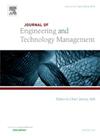外部协作网络知识关联与企业创新能力:内部发明者协作网络的调节作用
IF 3.9
3区 管理学
Q2 BUSINESS
Journal of Engineering and Technology Management
Pub Date : 2025-09-27
DOI:10.1016/j.jengtecman.2025.101918
引用次数: 0
摘要
在开放式创新背景下,有效整合内外部协作网络,利用相关知识,是提升创新能力的关键。目前的研究在很大程度上忽视了外部协作网络中知识关联度(相似性和互补性)对企业创新能力的潜在非线性影响,特别是过度关联度导致的创新抑制风险。此外,对于内部发明人协作网络如何调节这种关系,尚缺乏系统的研究。本文以189家上市公司为样本,运用社会网络分析和负二项回归模型,探讨了两个关键问题:(1)外部协作网络中的知识关联度是否非线性影响企业创新能力?(2)内部协作网络的结构如何影响这种关系?研究结果表明,知识相似性(企业内部知识的一致性)和知识互补性(共享资源之间的差异)与企业创新能力之间存在倒u型关系。适度的知识相似度和知识互补性最有利于企业创新能力的提升。此外,内部发明人协作网络的传递性增强了知识关联对创新的影响,而网络的稳定性则削弱了知识关联对创新的影响。这些研究结果拓展了吸收能力理论在网络创新背景下的应用,为企业优化合作伙伴选择和完善内部协作机制提供了理论依据。本文章由计算机程序翻译,如有差异,请以英文原文为准。
External collaboration network knowledge relatedness and firm innovation capability: The moderating effect of the internal inventor collaboration network
In the context of open innovation, effectively integrating internal and external collaborative networks to leverage relevant knowledge is crucial for enhancing innovation capabilities. Current research has largely overlooked the potential non-linear effects of knowledge relatedness (similarity and complementarity) in external collaboration networks on firm innovation capability, particularly the risk of innovation suppression caused by excessive relatedness. Moreover, systematic investigation is still lacking regarding how internal inventor collaboration networks moderate this relationship. Using a sample of 189 publicly listed firms and employing social network analysis along with negative binomial regression modeling, this study addresses two key questions: (1) Does knowledge relatedness in external collaboration networks nonlinearly affect firm innovation capability? (2) How does the structure of internal collaboration networks influence this relationship? The findings reveal an inverted U-shaped relationship between both knowledge similarity (the alignment of a firm's internal knowledge) and knowledge complementarity (differences between shared resources) and firm innovation capability. Moderate levels of knowledge similarity and complementarity are most conducive to enhancing innovation capability. Furthermore, transitivity within internal inventor collaboration networks strengthens the effect of knowledge relatedness on innovation, whereas network stability weakens it. These results extend the application of absorptive capacity theory in network innovation contexts and offer a theoretical basis for firms to optimize partner selection and improve internal collaboration mechanisms.
求助全文
通过发布文献求助,成功后即可免费获取论文全文。
去求助
来源期刊
CiteScore
8.00
自引率
6.20%
发文量
29
审稿时长
>12 weeks
期刊介绍:
The Journal of Engineering and Technology Management (JET-M) is an international scholarly refereed research journal which aims to promote the theory and practice of technology, innovation, and engineering management.
The journal links engineering, science, and management disciplines. It addresses the issues involved in the planning, development, and implementation of technological capabilities to shape and accomplish the strategic and operational objectives of an organization. It covers not only R&D management, but also the entire spectrum of managerial concerns in technology-based organizations. This includes issues relating to new product development, human resource management, innovation process management, project management, technological fusion, marketing, technological forecasting and strategic planning.
The journal provides an interface between technology and other corporate functions, such as R&D, marketing, manufacturing and administration. Its ultimate goal is to make a profound contribution to theory development, research and practice by serving as a leading forum for the publication of scholarly research on all aspects of technology, innovation, and engineering management.

 求助内容:
求助内容: 应助结果提醒方式:
应助结果提醒方式:


